

Mesure de température 1-wire DS18B20 avec le Raspberry Pi. Le Raspberry Pi permet d’interagir avec le monde réel.

En particulier, il est possible de l’utiliser pour effectuer et afficher/enregistrer des mesures environnementales comme la température. Le cahier des charges était : afficher la température de la pièce sur une page web. L’heure du choix Après la lecture de nombreux articles et la consultation de documentations techniques, le choix se résumait à choisir un capteur analogiqueun capteur numérique Le premier n’est pas directement utilisable sur le Raspberry Pi, il délivre une tension/un courant analogique et nécessite la mise en oeuvre d’une carte de mesure avec convertisseur analogique => digital (ADC ou CAN). Dans les seconds, une famille est particulièrement adaptée au Raspberry Pi, c’est la série de 1-wire, ou capteurs utilisant un seul fil (nous verrons qu’il faut… trois tout de même).
Arduino Nano: DHT11 Temperature and Humidity I2C 2 X 16 LCD Display With Visuino: 13 Steps. I already made two Instructables on how to use DTH11/DTH21/DTH22 and AM2301 Temperature and Humidity sensors with Arduino, and you can find them here and here .
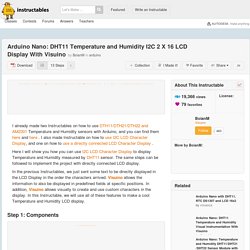
I also made Instructable on how to use I2C LCD Character Display, and one on how to use a directly connected LCD Character Display . Here I will show you how you can use I2C LCD Character Display to display Temperature and Humidity measured by DHT11 sensor. The same steps can be followed to implement the project with directly connected LCD display. In the previous Instructables, we just sent some text to be directly displayed in the LCD Display in the order the characters arrived.
Visuino allows the information to also be displayed in predefined fields at specific positions. DHT11 Temperature and Humidity with LCD Display. The data from DHT11 Sensor send to Arduino UNO and then displaying the humidity and temperature on the I2C LCD Display.

Parts List Arduino UNOI2C LCD display 16×2DHT11 Temperature and Humidity Sensor4.7k resistor Library. Sonde de température et consommation d’énergie. Accueil > Arduino, Matériel > Sonde de température et consommation d’énergie Le but de cet article est de commencer à tester une sonde à partir d’un Arduino pro mini 8 Mhz et d’un capteur de température et d’hygrométrie DHT22; ensuite nous verrons comment baisser la consommation de la sonde.
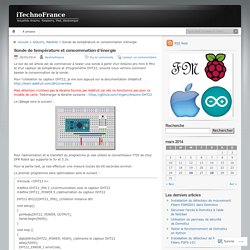
Pour l’utilisation du capteur DHT22, je me suis appuyé sur la documentation d’Adafruit Mais attention n’utilisez pas la librairie fournie par Adafruit car elle ne fonctionne pas pour ce modèle de carte. Télécharger la librairie suivante : Electronique microcontroleurs embarquées, mesures de grandeurs physiques et traitement. Réaliser un appareil de mesure utile lorsque l’on à comme moi un terrarium avec un « biotope » à surveiller.

Rien de plus simple et les infos sur internet ne manquent pas. Il existe 2 versions du capteur, le DHT11 et le DHT22. Grove - Temperature and Humidity Sensor Pro - Seeed Wiki. Introduction This is a powerful sister version of our Grove - Temperature and Humidity Sensor.
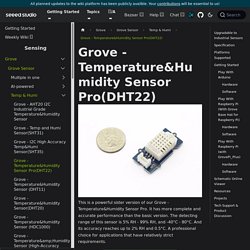
It has more complete and accurate performance than the basic version. The detecting range of this sensor is 5% RH - 99% RH, and -40°C - 80°C. And its accuracy reaches up to 2% RH and 0.5°C. A professional choice for applications that have relatively strict requirements. Specification Tip More details about Grove modules please refer to Grove System. Utiliser un capteur de température et d'humidité DHT11 / DHT22 avec une carte Arduino / Genuino. Using a Thermistor. Connecting to a Thermistor These thermistors are pretty hardy, you can strip the PVC insulation and stick the wires into a breadboard or solder to them directly.

Of course you can cut or extend the wires. Since the resistance is pretty high (10Kohm) the wire resistance won't make a huge difference. Analog Voltage Reading Method To measure the temperature, we need to measure the resistance. Say the fixed resistor is 10K and the variable resistor is called R - the voltage output (Vo) is: Vo = R / (R + 10K) * Vcc Where Vcc is the power supply voltage (3.3V or 5V) Now we want to connect it up to a microcontroller.
ADC value = Vi * 1023 / Vcc. Thermistor2. This is a function I wrote to convert the value from an analogRead call of a pin with a thermistor connected to it to a temperature.
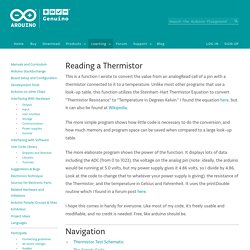
Unlike most other programs that use a look-up table, this function utilizes the Steinhart-Hart Thermistor Equation to convert "Thermistor Resistance" to "Temperature in Degrees Kelvin. " I found the equation here, but it can also be found at Wikipedia. The more simple program shows how little code is necessary to do the conversion, and how much memory and program space can be saved when compared to a large look-up table. The more elaborate program shows the power of the function. It displays lots of data including the ADC (from 0 to 1023), the voltage on the analog pin (note: ideally, the arduino would be running at 5.0 volts, but my power supply gives it 4.86 volts, so I divide by 4.86.
I hope this comes in handy for everyone. Arduino 1-Wire Address Finder. This tutorial has been updated to use version 1.0+ of the Arduino software, and compatible libraries.

Please download the latest version of the Arduino software here: 1-Wire devices, such as the DS18B20 digital temperature sensor, are great to use with Arduino boards because you can connect many of them to a single IO pin. The freely available software libraries and example code make using 1-wire devices simple. There is only one problem we have seen with the examples on the web. DS18B20 : How to change resolution (9/10/11/12 bits)? DS18B20 from Maxim (formerly Dallas) is a great chip for measuring temperature in your projects.
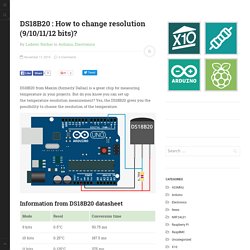
But do you know you can set up the temperature resolution measurement? Yes, the DS18B20 gives you the possibility to choose the resolution of the temperature. Information from DS18B20 datasheet The DS18B20 has an internal register in which the user can set values (called scratchpad). User can modify Byte 2,3 and 4. On our case, we will focus on the Byte 4 which is called the “configuration register” and which contains the bits used to select the resolution. The EEPROM will then save this resolution in order that after a power disconnection, the component will keep this resolution as default. Let’s now talk about the Byte 4 Configuration Register: This byte contains two bits which are used to change resolution: R0 and R1. ArduinoExpertCapteursComplexesDS18B20ThermometreSimple.
ARDUINO - ONEWIRE - CAPTEURSCOMPLEXESPar X. Tweaking4All.com - How to measure temperature with your Arduino and a DS18B20. In this example project we will be combining an Arduino and a DS18B20 temperature sensor. The DS18B20 is a so called 1-wire digital temperature sensor. The words “digital” and “1-wire” make this sensor really cool and allows you, with a super simple setup, to read the temperature of one or more sensors. You can even connect multiple devices together, utilizing only one pin on your Arduino. The more I play with the Arduino, the more fun it gets Arduino and DS18B20 Temperature Sensor The DS18B20 comes in different forms and shapes, so you have plenty of choice when deciding which one works best for you.